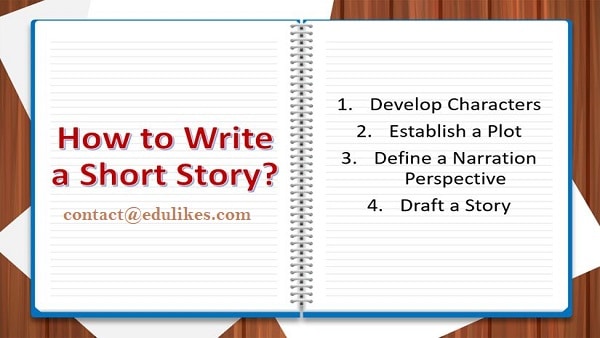Tips for Crafting Impactful Narratives in Limited Space
Home » Education » Tips for Crafting Impactful Narratives in Limited Space
Do you dream of writing compelling and concise stories but struggling to fit them into a concise and compelling narratives in Limited Space? Fear not.
It is difficult to write a short book since there is so much to do in so little space: establish your characters, build to a climax, and wrap up the primary conflict. With the help of tried and tested tricks on how to write short stories, in no time, you will win your readers’ hearts and minds.
Short stories are a fascinating literary form that allows writers to craft impactful narratives in limited space. Unlike novels, short stories demand a concise yet powerful style that captures readers’ attention and holds it until the very end.
6 Simple Steps to Write a Short Story
Every great short story begins with a captivating idea that educate the writer’s imagination and sets the stage for a powerful narrative. But, coming up with good short story ideas can be daunting, leaving writers feeling lost and uninspired.
Therefore, it becomes important to learn how to write short stories to make a difference in this field. Also, to engage the readers, the right strategy will work.
Here are the six steps for creating impactful stories:
Choose a Theme
Before you start writing, you need to choose a theme for your story. A theme is a central idea or message you want to convey to your readers. Love, loss, redemption, or anything else that resonates with you. Your theme will shape the plot and characters of your story, so choose something that speaks to you.
Do not Use Too Many Characters
Once you have your theme, you need to develop your characters. Your characters are the people who will bring your story to life. Think about who they are, what they want, and how to write short stories that interact with each other.
On the other hand, having too many characters in a short story makes it harder for the reader to keep track of what’s happening.
The reader needs someone to root for, someone to hate, and sometimes someone who helps the protagonist or antagonist grow as a character. Give them distinct personalities, backgrounds, and motivations. The more well-rounded your characters are, the more engaging your story will be.
Create a Plot Outline
Now that you have your theme and characters, it’s time to create a plot outline. A plot outline is a roadmap for your story. It includes the beginning, middle, and end of your story, as well as the major events that will happen along the way. Use your theme and characters to guide your plot outline and ensure a clear and satisfying resolution.
Write the First Draft
With your plot outline in hand, it’s time to start writing the first draft of your story. Don’t worry about perfecting it the first time – the goal is to get your ideas down on paper. Write freely and let the story unfold naturally. Don’t be afraid to make mistakes. Learn how to write short stories or take risks – you can edit later.
Edit and Revise
Once you have a complete first draft, it’s time to edit and revise your story. Read it over carefully, looking for grammar, punctuation, and spelling errors. Ensure your characters are consistent, your plot makes sense, and your theme is clear. You may need to rewrite some sections or cut others entirely. This process may take several rounds of editing, but don’t give up – your story will be stronger for it.
Share Your Story
Finally, it’s time to share your story with the world. Whether you submit it to a literary magazine, share it with friends and family, or post it online, be proud of what you’ve accomplished. Writing a short story takes time and effort, but the satisfaction of seeing your ideas come to life is worth it.
Tips for Writing a Compelling Short Story
Short stories are a wonderful way to explore the depths of human emotion and convey powerful messages in a condensed format. Despite their brevity, crafting a compelling short story is no easy feat. It takes skill, creativity, and a keen understanding of storytelling elements.
Whether you are a seasoned writer or a beginner, try to hone your skills. Certain tips and techniques can help you know how to write short stories that captivate and resonate with your audience.
Below are the tips mentioned by ghostwriting services experts for writing short stories successfully:
- Start with a clear idea or theme that resonates with you
- Keep your story focused on a single event or moment
- Develop interesting and well-rounded characters that readers can relate to
- Create a plot outline that includes a clear beginning, middle, and end
- Use active and descriptive language to bring your story to life
- Show, do not tell – only use descriptive details to help readers visualize the scene
- Use dialogue to reveal character traits and move the plot forward
- Keep your story concise and avoid unnecessary details or tangents
- Avoid clichés and overused tropes by putting your unique spin on your story
- Experiment with different perspectives, voices, and structures to find what works best for your story
- Revise and edit your story multiple times to ensure that it’s polished and error-free
- Read widely in the genre to learn from other writers and find inspiration for your work.
Begin Your Writing Journey Now
The art of writing short stories is a unique and fascinating craft that requires careful consideration and skill. With the right approach and mindset, anyone can learn how to write short stories and create impactful narratives that resonate with readers long after the final page is turned. So, take a deep breath, pick up your pen, and let your imagination soar as you write your next great short story.


